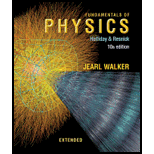
Fundamentals of Physics Extended
10th Edition
ISBN: 9781118230725
Author: David Halliday, Robert Resnick, Jearl Walker
Publisher: Wiley, John & Sons, Incorporated
expand_more
expand_more
format_list_bulleted
Concept explainers
Textbook Question
thumb_up100%
Chapter 6, Problem 9P
GO A 3.5 kg block is pushed along a horizontal floor by a force
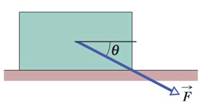
Figure 6-19 Problem 9 and 32.
Expert Solution & Answer
Want to see the full answer?
Check out a sample textbook solution
Students have asked these similar questions
A block of mass m is initially at rest at the highest point of an inclined plane, which has a height of 5.1 m and has an angle of θ = 16° with respect to the horizontal. After being released, it is found to be moving at v = 0.55 m/s a distance d after the end of the inclined plane as shown. The coefficient of kinetic friction between the block and the plane is μp = 0.1, and the coefficient of friction on the horizontal surface is μr = 0.2. Find the distance, d, in meters.
In Fig. 6-23, a sled is held on an inclined plane by a cord pulling directly up the plane. The sled is to be on the verge of moving up the plane. In Fig. 6- 28, the magnitude F required of the cord’s force on the sled is plotted versus a range of values for the coefficient of static friction ms between sled and plane: F1 = 2.0 N, F2 = 5.0 N, and m2 = 0.50. At what angle u is the plane inclined?
A block of mass m is initially at rest at the top of an inclined plane, which has a height of 4.2 m and makes an angle θ = 17° with respect to the horizontal. After sliding down the ramp, the brick is observed to be moving at v = 0.95 m/s at a distance d from the end of the inclined plane. The coefficient of kinetic friction between the block and the plane is μp = 0.1, and the coefficient of friction on the horizontal surface is μr = 0.2.
1. what is the speed of block, in meters per second, just after it leaves the inclined plane
2. find the distance, d, in meters
Chapter 6 Solutions
Fundamentals of Physics Extended
Ch. 6 - In Fig. 6-12, if the box is stationary and the...Ch. 6 - Prob. 2QCh. 6 - In Fig. 6-13, horizontal force F1 of magnitude 10...Ch. 6 - In three experiments, three different horizontal...Ch. 6 - If you press an apple crate against a wall so hard...Ch. 6 - In Fig. 6-14, a block of mass m is held stationary...Ch. 6 - Reconsider Question 6 but with the force F now...Ch. 6 - In Fig. 6-15, a horizontal force of 100 N is to be...Ch. 6 - Prob. 9QCh. 6 - Prob. 10Q
Ch. 6 - A person riding a Ferris wheel moves through...Ch. 6 - During a routine flight in 1956, test pilot Tom...Ch. 6 - A box is on a ramp that is at angle to the...Ch. 6 - The floor of a railroad flatcar is loaded with...Ch. 6 - In a pickup game of dorm shuffleboard, students...Ch. 6 - SSM WWW A bedroom bureau with a mass of 45 kg,...Ch. 6 - A slide-loving pig slides down a certain 35 slide...Ch. 6 - GO A 2.5 kg block is initially at rest on a...Ch. 6 - A baseball player with mass m 79 kg, sliding into...Ch. 6 - SSM ILW A person pushes horizontally with a force...Ch. 6 - The mysterious sliding stones. Along the remote...Ch. 6 - GO A 3.5 kg block is pushed along a horizontal...Ch. 6 - Figure 6-20 shows an initially stationary block of...Ch. 6 - SSM A 68 kg crate is dragged across a floor by...Ch. 6 - In about 1915, Henry Sincosky of Philadelphia...Ch. 6 - A worker pushes horizontally on a 35 kg crate with...Ch. 6 - Figure 6-22 shows the cross section of a road cut...Ch. 6 - The coefficient of static friction between Teflon...Ch. 6 - A loaded penguin sled weighing 80 N rests on a...Ch. 6 - In Fig. 6-24, a force P acts on a block weighing...Ch. 6 - GO You testify as an expert witness in a case...Ch. 6 - A 12 N horizontal force F pushes a block weighing...Ch. 6 - GO In Fig. 6-27, a box of Cheerios mass mC = 1.0...Ch. 6 - An initially stationary box of sand is to be...Ch. 6 - GO In Fig. 6-23, a sled is held on an inclined...Ch. 6 - When the three blocks in Fig. 6-29 are released...Ch. 6 - A 4.10 kg block is pushed along a floor by a...Ch. 6 - SSM WWW Block B in Fig. 6-31 weighs 711 N. The...Ch. 6 - GO Figure 6-32 shows three crates being pushed...Ch. 6 - GO Body A in Fig. 6-33 weighs 102 N, and body B...Ch. 6 - In Fig. 6-33, two blocks are connected over a...Ch. 6 - GO In Fig. 6-34, blocks A and B have weights of 44...Ch. 6 - A toy chest and its contents have a combined...Ch. 6 - SSM Two blocks, of weights 3.6 N and 7.2 N, are...Ch. 6 - GO A block is pushed across a floor by a constant...Ch. 6 - SSM A 1000 kg boat is traveling at 90 km/h when...Ch. 6 - GO In Fig. 6-37, a slab of mass m1= 40 kg rests on...Ch. 6 - ILW The two blocks m = 16 kg and M = 88 kg in Fig....Ch. 6 - The terminal speed of a sky diver is 160 km/h in...Ch. 6 - Continuation of Problem 8. Now assume that Eq....Ch. 6 - Assume Eq. 6-14 gives the drag force on a pilot...Ch. 6 - Calculate the ratio of the drag force on a jet...Ch. 6 - In downhill speed skiing a skier is retarded by...Ch. 6 - A cat dozes on a stationary merry-go-round in an...Ch. 6 - Suppose the coefficient of static friction between...Ch. 6 - ILW What is the smallest radius of an unbanked...Ch. 6 - During an Olympic bobsled run, the Jamaican team...Ch. 6 - SSM ILW A student of weight 667 N rides a steadily...Ch. 6 - A police officer in hot pursuit drives her car...Ch. 6 - A circular-motion addict of mass 80 kg rides a...Ch. 6 - A roller-coaster car at an amusement park has a...Ch. 6 - GO In Fig. 6-39, a car is driven at constant speed...Ch. 6 - An 85.0 kg passenger is made to move along a...Ch. 6 - SSM WWW An airplane is flying in a horizontal...Ch. 6 - An amusement park ride consists of a car moving in...Ch. 6 - An old streetcar rounds a flat corner of radius...Ch. 6 - In designing circular rides for amusement parks,...Ch. 6 - A bolt is threaded onto one end of a thin...Ch. 6 - GO A banked circular highway curve is designed for...Ch. 6 - GO A puck of mass m = 1.50 kg slides in a circle...Ch. 6 - Brake or turn? Figure 6- 44 depicts an overhead...Ch. 6 - SSM ILW In Fig. 6-45, a 1.34 kg ball is connected...Ch. 6 - GO In Fig. 6-46, a box of ant aunts total mass m1...Ch. 6 - SSM A block of mass mt = 4.0 kg is put on top of a...Ch. 6 - A 5.00 kg stone is rubbed across the horizontal...Ch. 6 - In Fig. 6-49, a 49 kg rock climber is climbing a...Ch. 6 - A high-speed railway car goes around a flat,...Ch. 6 - Continuation of Problems 8 and 37. Another...Ch. 6 - GO In Fig. 6-50, block 1 of mass m1 = 2.0 kg and...Ch. 6 - In Fig. 6-51, a crate slides down an inclined...Ch. 6 - Engineering a highway curve. If a car goes through...Ch. 6 - A student, crazed by final exams, uses a force P...Ch. 6 - GO Figure 6-53 shows a conical pendulum, in which...Ch. 6 - An 8.00 kg block of steel is at rest on a...Ch. 6 - A box of canned goods slides down a ramp from...Ch. 6 - In Fig. 6-54, the coefficient of kinetic friction...Ch. 6 - A 110 g hockey puck sent sliding over ice is...Ch. 6 - A locomotive accelerates a 25-car train along a...Ch. 6 - A house is built on the top of a hill with a...Ch. 6 - What is the terminal speed of a 6.00 kg spherical...Ch. 6 - A student wants to determine the coefficients of...Ch. 6 - SSM Block A in Fig. 6-56 has mass mA = 4.0 kg, and...Ch. 6 - Calculate the magnitude of the drag force on a...Ch. 6 - SSM A bicyclist travels in a circle of radius 25.0...Ch. 6 - In Fig. 6-57, a stuntman drives a car without...Ch. 6 - You must push a crate across a floor to a docking...Ch. 6 - In Fig. 6-58, force F is applied to a crate of...Ch. 6 - In the early afternoon, a car is parked on a...Ch. 6 - A sling-thrower puts a stone 0.250 kg in the...Ch. 6 - SSM A car weighing 10.7 kN and traveling at 13.4...Ch. 6 - In Fig. 6-59, block 1 of mass m1 = 2.0 kg and...Ch. 6 - SSM A filing cabinet weighing 556 N rests on the...Ch. 6 - In Fig. 6-60, a block weighing 22 N is held at...Ch. 6 - Prob. 91PCh. 6 - A circular curve of highway is designed for...Ch. 6 - A 1.5 kg box is initially at rest on a horizontal...Ch. 6 - A child weighing 140 N sits at rest at the top of...Ch. 6 - In Fig. 6-61 a fastidious worker pushes directly...Ch. 6 - A child places a picnic basket on the outer rim of...Ch. 6 - SSM A warehouse worker exerts a constant...Ch. 6 - In Fig. 6-62, a 5.0 kg block is sent sliding up a...Ch. 6 - An 11 kg block of steel is at rest on a horizontal...Ch. 6 - A ski that is placed on snow will stick to the...Ch. 6 - Playing near a road construction site, a child...Ch. 6 - A 100 N force, directed at an angle above a...Ch. 6 - A certain string can withstand a maximum tension...Ch. 6 - A four-person bobsled total mass = 630 kg comes...Ch. 6 - As a 40 N block slides down a plane that is...
Additional Science Textbook Solutions
Find more solutions based on key concepts
What do you think explains the placebo effect?
Conceptual Integrated Science
Why communication satellites do not used ultraviolet waves to receive information.
Glencoe Physical Science 2012 Student Edition (Glencoe Science) (McGraw-Hill Education)
To excite an election in a one-dimensional box from its first excited state to its third excited state requires...
University Physics Volume 3
An aluminum calorimeter with a mass of 100 g contains 250 g of water. The calorimeter and water are in thermal ...
Physics for Scientists and Engineers, Technology Update (No access codes included)
Bond strengths are frequently given in units of kilojoules per mole. Find the molecular dissociation energy (in...
MODERN PHYSICS (LOOSELEAF)
Playing in the street, a child accidentally tosses a ball at 18 m/s toward the front of a car moving toward him...
Essential University Physics: Volume 1 (3rd Edition)
Knowledge Booster
Learn more about
Need a deep-dive on the concept behind this application? Look no further. Learn more about this topic, physics and related others by exploring similar questions and additional content below.Similar questions
- A crate of mass m is initially at rest at the highest point of an inclined plane which has a height of 5.28 m and makes an angle of A = 17.2° with respect to the horizontal. After it has been released, it is found to be traveling at v = 0.29 m/s a distance dafter the end of the inclined plane, as shown. The coefficient of kinetic friction between the crate and the plane is tp = 0.1, and the coefficient of friction on the horizontal surface is f4r = 0.2.arrow_forwardA 14 kg block measures 7 cm by 9 cm by 25 cm. When it slides on a 9 cm by 25 cm face, it moves with constant speed when pulled horizontally by a force whose magnitude is 17 N. How big a horizontal force must be applied to pull it with constant speed if it slides on a 7 cm by 25 cm face?arrow_forwardIn Fig. 6-59, block 1 of mass m1 ? 2.0 kg and block 2 of mass m2 ? 1.0 kg are connected by a string of negligible mass. Block 2 is pushed by force F of magnitude 20 N and angle u ? 35°. The coefficient of kinetic friction between each block and the horizontal surface is 0.20. What is the tension in the string? (please don't copy-paste solution)arrow_forward
- A skier starts from rest at the top of a hill that is inclined 10.5°with respect to the horizontal. The hillside is 2.00 x 102 m long,and the coefficient of friction between snow and skis is 0.075 0.At the bottom of the hill, the snow is level and the coefficientof friction is unchanged. How far does the skier glide along thehorizontal portion of the snow before coming to rest?arrow_forwardA box of mass m is initially at rest at the top of an inclined plane, which has aheight of 4.4 m and has an angle of 0 = 24° with respect to the horizontal. After letting go of theobject, you perceive it to be traveling at v = 1 m/s a distance d after the end of the inclined plane asshown. The coefficient of kinetic friction between the box and the plane is Up= 0.1, and the coefficient of friction on the horizontal surface is Ur, = 0.2. please, (a) What is the speed of the box, in meters per second, just after it leaves the inclined plane? (b) What is the distance, d, in meters.arrow_forwardThe crate, which has a mass of 100 kg, is subjected to the action of the forces. If it is originally at rest, determine the distance it slides in order to attain a speed of 6/m. The coefficient of kinetic friction between the crate and the surface is µk=0.2.arrow_forward
- A skier is on a 25 degree slope and his mass is 80kg. If his constant velocity and the coefficient of kinetic friction between the ski and the snow is 9 m/s and 0.80, respectively, compute his velocity when he has skid 20m from his initial position and a drag force experienced by the skier equivalent to a magnitude of 0.6V^2.arrow_forwardA particle, of mass 6 kg, is in equilibrium on a rough horizontal plane under a force of magnitude T N, which acts at an angle 15 above the horizontal. Given the coefficient of friction between the particle and the rough horizontal plane is 0.35, what values could T take?arrow_forwardA crate of mass M is initially at rest at the highest point of an inclined plane, which has a height of 5.8 m and makes an angle of theta=27 degrees with respect to the horizontal.  after letting go of the object call you notice it to be traveling at v=0.35 m/s a distance d after the end of the inclined plane as shown. The coefficient of kinetic friction between the crate and the plane is up= 0.1, and the coefficient of friction on the horizontal surface is ur=0.2. (A) what is the speed of the crate, in meters per second, just after it leaves the inclined plane? (B) find the distance, d, in meters.arrow_forward
- Find the height upto which an insect can crawl up a fixed hemispherical bowl of radius r , the coefficient of friction=(1/3).arrow_forwardA skier is on a 25° slope and his mass is 80kg. If his constant velocity and the coefficient of kinetic friction between the ski and the snow is 9 m/s and 0.80, respectively, compute his velocity when he has skid 20m from his initial position and a drag force experienced by the skier equivalent to a magnitude of 0.6V^2.arrow_forwardA block of mass 4 kg is pushed with an initial speed of 1.0 m/ s up an inclined plane raised 20° above the horizontal. If the coefficients of static and kinetic friction are 0.3 and 0.1 respectively , how far along the plane does the ball slide before stopping?arrow_forward
arrow_back_ios
SEE MORE QUESTIONS
arrow_forward_ios
Recommended textbooks for you
 College PhysicsPhysicsISBN:9781305952300Author:Raymond A. Serway, Chris VuillePublisher:Cengage Learning
College PhysicsPhysicsISBN:9781305952300Author:Raymond A. Serway, Chris VuillePublisher:Cengage Learning University Physics (14th Edition)PhysicsISBN:9780133969290Author:Hugh D. Young, Roger A. FreedmanPublisher:PEARSON
University Physics (14th Edition)PhysicsISBN:9780133969290Author:Hugh D. Young, Roger A. FreedmanPublisher:PEARSON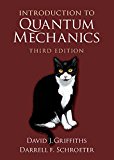 Introduction To Quantum MechanicsPhysicsISBN:9781107189638Author:Griffiths, David J., Schroeter, Darrell F.Publisher:Cambridge University Press
Introduction To Quantum MechanicsPhysicsISBN:9781107189638Author:Griffiths, David J., Schroeter, Darrell F.Publisher:Cambridge University Press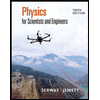 Physics for Scientists and EngineersPhysicsISBN:9781337553278Author:Raymond A. Serway, John W. JewettPublisher:Cengage Learning
Physics for Scientists and EngineersPhysicsISBN:9781337553278Author:Raymond A. Serway, John W. JewettPublisher:Cengage Learning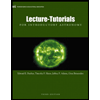 Lecture- Tutorials for Introductory AstronomyPhysicsISBN:9780321820464Author:Edward E. Prather, Tim P. Slater, Jeff P. Adams, Gina BrissendenPublisher:Addison-Wesley
Lecture- Tutorials for Introductory AstronomyPhysicsISBN:9780321820464Author:Edward E. Prather, Tim P. Slater, Jeff P. Adams, Gina BrissendenPublisher:Addison-Wesley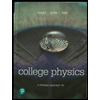 College Physics: A Strategic Approach (4th Editio...PhysicsISBN:9780134609034Author:Randall D. Knight (Professor Emeritus), Brian Jones, Stuart FieldPublisher:PEARSON
College Physics: A Strategic Approach (4th Editio...PhysicsISBN:9780134609034Author:Randall D. Knight (Professor Emeritus), Brian Jones, Stuart FieldPublisher:PEARSON

College Physics
Physics
ISBN:9781305952300
Author:Raymond A. Serway, Chris Vuille
Publisher:Cengage Learning

University Physics (14th Edition)
Physics
ISBN:9780133969290
Author:Hugh D. Young, Roger A. Freedman
Publisher:PEARSON

Introduction To Quantum Mechanics
Physics
ISBN:9781107189638
Author:Griffiths, David J., Schroeter, Darrell F.
Publisher:Cambridge University Press

Physics for Scientists and Engineers
Physics
ISBN:9781337553278
Author:Raymond A. Serway, John W. Jewett
Publisher:Cengage Learning

Lecture- Tutorials for Introductory Astronomy
Physics
ISBN:9780321820464
Author:Edward E. Prather, Tim P. Slater, Jeff P. Adams, Gina Brissenden
Publisher:Addison-Wesley

College Physics: A Strategic Approach (4th Editio...
Physics
ISBN:9780134609034
Author:Randall D. Knight (Professor Emeritus), Brian Jones, Stuart Field
Publisher:PEARSON
Work and Energy - Physics 101 / AP Physics 1 Review with Dianna Cowern; Author: Physics Girl;https://www.youtube.com/watch?v=rKwK06stPS8;License: Standard YouTube License, CC-BY